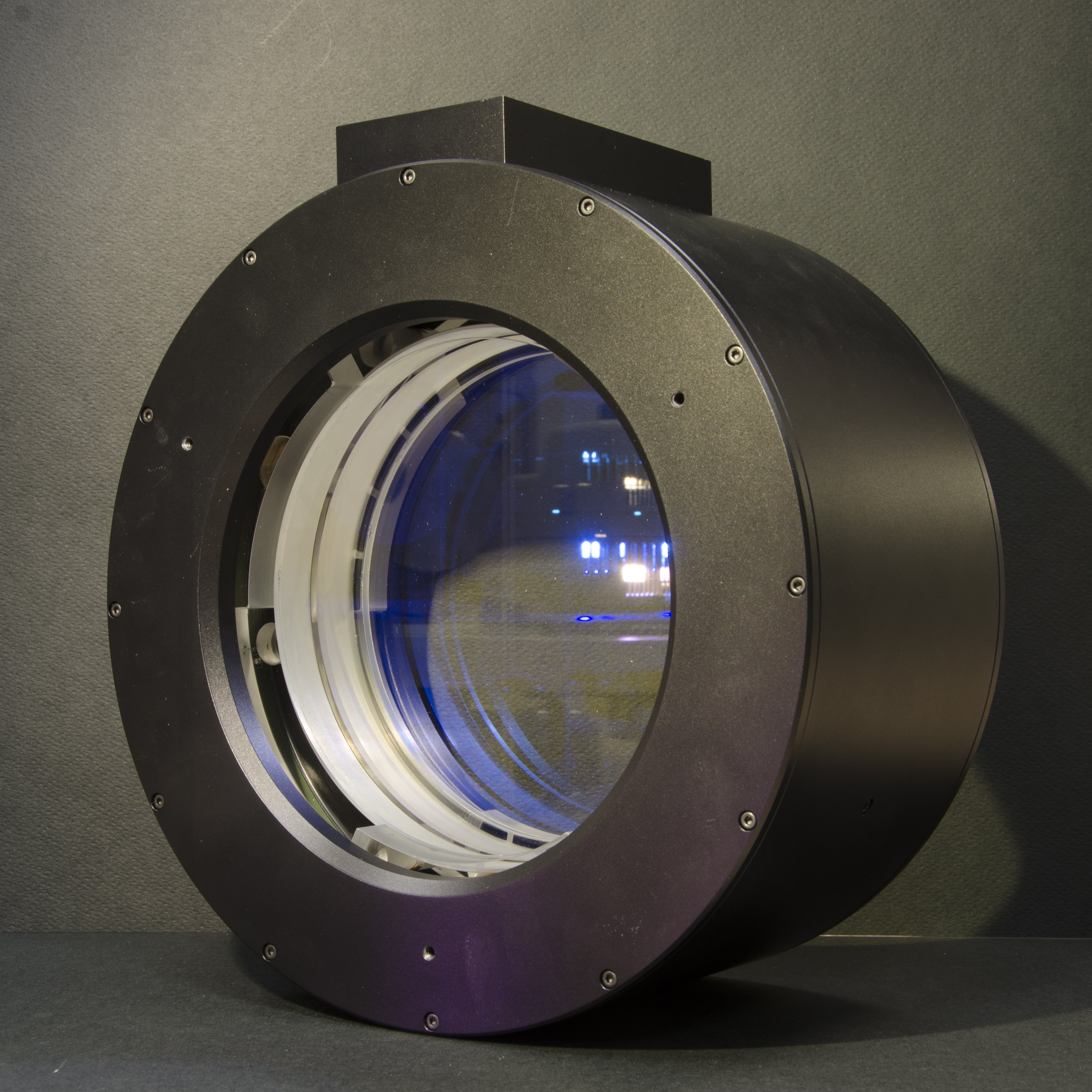Work is underway to complete the preliminary design of the Tunable-Band Imagers of EST by December 2022. An international group has been formed to that end.
 Figure 1. Prototype of a 150 mm clear-aperture etalon for EST developed by ICOS in collaboration with UTOV, INO, INAF and ADS. Credit: V. Greco / INO
Figure 1. Prototype of a 150 mm clear-aperture etalon for EST developed by ICOS in collaboration with UTOV, INO, INAF and ADS. Credit: V. Greco / INO
Tunable-Band Imagers (TBIs) are used in solar physics to capture phenomena that cannot be studied otherwise. Their ability to image the Sun (small resolved regions of it) in very narrow wavelength bands, scanning a spectral line in short periods of time, enables the identification of (magnetic) features and their time evolution in a way that no other instrument can achieve. As part of the instrument suite of EST, TBIs complement the information provided by spectrographs based on Integral Field Units (IFUs), which aim at diagnosing similar features but with a different approach. TBIs are also complemented by Broad-Band Imagers (BBIs). These instruments deliver excellent morphological context of the solar scene.
TBIs provide full spectropolarimetric diagnostics of the portion of the Sun they observe. Spectropolarimetry embraces all the properties we can measure to characterize the light emitted by the Sun: intensity (basically energy), wavelength (color), and polarization (a way to understand the plane where light as a wave is oscillating). It is only by measuring light that we can understand the physical state of our star.
TBI is indeed a bad name for Tunable Imaging Spectropolarimeter (TIS), that is, a device that makes images of the polarization state of light in narrow band wavelength regions of the spectrum that can be selected at will. It is a bad name because they measure polarization, as opposed to BBIs which are real imagers.
Recently, a group of European solar physicists from the Leibniz-Institut für Sonnenphysik (KIS; Germany), Università di Roma Tor Vergata (UTOV; Italy), Instituto de Astrofísica de Andalucía (IAA-CSIC; Spain), and the Institute for Solar Physics of Stockholm University (SU; Sweden), led by the IAA-CSIC Solar Physics Group in Granada, has been formed to carry out the tasks of a conceptual design of the TBI instruments for EST. A number of such TBI devices have been constructed in different solar telescopes with different technologies. We shall concentrate here on those based on Fabry-Pérot interferometers (also called etalons; see Figure 1) as the means to select a narrow band of the spectrum, typically across a photospheric or chromospheric spectral line. A (our) TIS needs, thus, an etalon system to carry out the spectral analysis, a polarimeter to measure the four Stokes profiles of light, and an optical system that images the Sun on the detector(s). The conceptual design includes choices for the type and number of etalons, the type of polarimeter, the spectral resolution, the number of wavelength samples, and many other requirements that flow down from the scientific requirements elaborated by the EST Scientific Advisory Group. Three TIS are envisaged for EST to cover the spectrum from 380 to 500 nm, 500 to 780 nm, and 780 to 1000 nm.
Problems like the size of the etalons (they cannot be manufactured with current tools and procedures), the optical configuration of the etalons within the instrument (a really important matter), the kind of materials they are made of, the field of view (the size of the imaged area) they should cover, the way we are measuring the polarization of light, the type and quality of the light detectors, or the possible degradation induced by the image rotation of a telescope without compensation are topics that have been addressed by sub-groups of the whole working group, which formed in its first meeting in early July 2020. The work of the subgroups has been independent of the others and, after a co-location meeting held on 30 October, we are putting everything together in a report that will be submitted to the EST Project Office.
The discussion has built upon the previous TBI conceptual designs achieved in 2011 with their pros and cons, plus new calculations that enlighten the expected results. As in any other scientific design, we started with a number of assumptions that drive further decisions. Specifically, the EST TBIs will have a tandem of two air-gapped etalons, each with cavity (roughness) errors of less than 2 nm (they are virtually the flattest, smoothest surfaces on Earth), one of them with a high reflectivity coating and the other with a low reflectivity coating. This combination has proved very successful for the Crisp Imaging Spectropolarimeter (CRISP) and the Chromospheric Imaging Spectrometer (CHROMIS), two TBI instruments currently in operation at the Swedish 1m Solar Telescope on La Palma.
We started by collecting a number of requirements TBIs should comply with. The number of requirements has grown since and is still expected to grow. We aim at having a robust TBI General Requirements Document by early 2021. This will be the basis for the conceptual design of the instrument, which is expected by December 2022, when a preliminary design review will be held. All these developments will of course depend on the available funding.
MEMBERS OF THE GROUP
|
- Francisco J. Bailén, IAA-CSIC
- Nazaret Bello González, KIS
- Luis Bellot Rubio, IAA-CSIC
- Francesco Berrilli, UTOV
- Luca Giovanelli, UTOV
- Mats Löfdahl, SU
- Oskar von der Lühe, KIS
- Dario del Moro, UTOV
- David Orozco Suárez, IAA-CSIC
- Göran Scharmer, SU
- Rolf Schlichenmaier, KIS
- Jose Carlos del Toro Iniesta, IAA-CSIC
